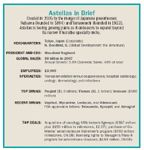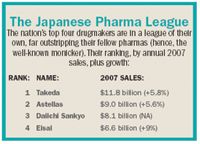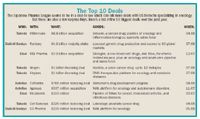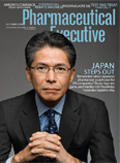Global Warming
Pharmaceutical Executive
Japan is playing a game of catch-up, dropping big cash on biotechs and risky acquisitions. But with patents expiring and sales falling, can they really pay their way to global success?
Yoshihiko Hatanaka is a slight, smiling man in late middle age and a dark blue business suit. When we meet, he shakes my hand only after bowing, presenting his business card, and telling me his title: president and CEO of Astellas Pharma US. There is a touching humanity about this little ritual; Mr. Hatanaka's silky formality, a touchstone of the Japanese professional class, contrasts dramatically with US executive style, which, however polished, tends to reveal the stresses and strains of the personality inside the suit.
In a 45-minute interview, Mr. Hatanaka shows no sign of stress or strain—a noteworthy fact, because some analysts believe that Astellas (formed in 2005 by the merger of Yamanouchi and Fujisawa) may be heading for a fall. Although his English is halting, Hatanaka effortlessly fields questions about Astellas' recent big moves, including a pricey biotech acquisition, some big-ticket platform licenses, the move of the firm's global development headquarters to the US—and the announcement last year that Astellas would close five plants and trim its workforce by 10 percent. (See "Astellas in Brief".)

Astellas in Brief
Despite his elegant manners, Hatanaka, who worked his way up the hierarchy at Astellas and Fujisawa over 26 years, is a plain talker when addressing the stark challenges driving Astellas' new direction. "For the last 10 years the Japanese market has stagnated because of price cuts," he says. "In the past, Japanese companies were satisfied with just the Japanese market and licensing out their assets in other markets. But now it is required that we go out to United States, Europe, and even emerging markets."
The Japanese Are Coming
Today, this "going out" is one of the drug industry's biggest stories. Just look at the deals involving the top four Japanese Pharma League: Takeda, Astellas, Daiichi Sanyko (another 2005 merger), and Eisai. (See "The Japanese Pharma League".) In the first eight months of 2008, Japanese pharma acquisitions added up to $42 billion—nearly twice last year's total, according to Thomson Reuters. This flurry of activity shows Japan's cash-rich drugmakers reading from the same playbook as Western Big Pharma: stocking up on biologics, especially in cancer, and setting up shop in nations with a fast-growing middle class. Necessity is the mother of imitation.

The Japanese Pharma League
In April, Takeda, the league's 800-pound gorilla, paid $8.8 billion for Millennium, the Boston-based maker of the cancer drug Velcade. Eisai has also been ramping up its cancer portfolio; its $3.9 billion purchase of Minnesota-based MGI last December was its third major oncology acquisition in two years. Meanwhile, Daiichi Sanyko bought a majority stake in Ranbaxy, India's generics juggernaut. For an estimated $3.4 billion to $4.6 billion, the Japanese company will make a big footprint in India, and gain a toehold just about everywhere else. (See "The Top 10 Deals.)

The Top 10 Deals
"Japanese pipelines have done a decent job with small-molecule drugs, but the industry has almost entirely missed the biotech revolution," says Toshiaki Iituka, a Japanese economist and professor at Aoyama Gakuin University's business school.
Discussing Astellas' recent $387 million up-front purchase of Agensys, a Santa Monica–based biotech with an oncology-focused monoclonal antibody platform, Hatanaka is candid about the need to play catch-up. "Oncology is highly competitive, the evolution of the science is so quick, and we don't have enough antibody technology within our company," he says.
Can Astellas and its compatriots catch up? Many observers would pose the question less politely: Is the company's way of doing business too "Japanese"—too painstaking and traditional, too risk-averse and consensus-oriented—to make the leap into a new age of innovation?
"The Japanese have been criticized for not being overly innovative in their drug development," says the Bruckner Group's Michael Russo. "It's 'Take an idea and do it better, but do not invent something new.'"
"The culture doesn't allow you to be a cowboy. It encourages conformity," says Miller Tabak's Les Funtleyder. "If they want to move into high-stakes R&D, they need a whole new approach to how they do things."
As if anticipating the "too 'Japanese'" issue, Hatanaka is accompanied by two American members of his management team: William Fitzsimmons, head of R&D, and Patrick Shea, head of marketing and sales. They sit on either side of Hatanaka and respectfully wait for him to defer to them, with a gesture of his hand, before elaborating on his own answers to my questions. The three form a tableau that illustrates the culture Hatanaka wants to create. "This is not just a Japanese company," he says. "It is not a US pharmaceutical. We are not a Big Pharma, we are not a start-up. We have selected our area and our strengths, and based on that we are building our strategy."
No Hope at Home
The global ambitions of Japanese pharma have been forced on the industry by economics. According to IMS Health, the Japanese domestic drug market grew last year by 3.8 percent, compared to a worldwide average of 6.4 percent. And although Japan's $59 billion market is second in size only to the US, it accounts for just 10 percent of the global total—half of the amount a decade ago.
At 11 of Japan's top 16 drug firms, sales are growing faster outside Japan than in the country. Astellas, a $9 billion company, reports that its domestic sales rose by all of 0.8 percent last year, compared to sales increases of 14.8 percent in the US and 11.4 percent in Europe.
Domestic hurdles have long hampered Japanese pharma's profitability and productivity. Government policies can be blamed for almost every aspect of the market's stagnation except one: demographics. These days, Japanese people are living longer (and require more meds), but have fewer children (future taxpayers). This imbalance has squeezed a national healthcare system that pays 90 percent of senior citizens' medical costs. In an effort to control ballooning expenditures, the government clings to its drug pricing controls—which have proved to be a drag on innovation.
Every two years, the government announces an across-the-board reduction in drug prices, typically 4 to 6 percent. This year, the cut was 5.2 percent, with an additional one-off 10 percent price slash for certain drugs, including Prograf, an immunosuppressant used by transplant patients—and Astellas' longtime cash cow.
"These mandatory price cuts have a neutralizing effect on any drug company's ability to grow," says AVOS Life Sciences' Jim Wahl. "They discourage investment in R&D, which discourages innovation, which discourages profits. It's a vicious cycle."
"The drug market in Japan is dying," says Toshiaki Iituka. "Many firms haven't produced a new drug for 10 years."
Japan's own health ministry has called this a "crisis" situation. According to a 2007 policy statement, "Since 2000, no major-league new drug has emerged from Japan." Yet among the proposed reforms, including a big push to popularize generics, the draconian price cuts went unmentioned.
And as Western giants like Pfizer and GlaxoSmithKline make incursions into the Japanese market, the writing is on the wall. Says IMS Consulting's Ray Hill, "The Japanese companies finally woke up to the fact that they have to defend their market at home and go global."
Coming of Age
But there's more to going global than buying biotechs, as Astellas showed by moving its global development headquarters to North Deerfield, IL, the old Fujisawa US base. "It was critical [for us to] get to the major pharmaceutical market in the world," says Fitzsimmons. "We also did it to have closer relationships with FDA, to tap into US and European talent, and to build on our two decades of infrastructure here."
In the 1980s, Fujisawa was the first Japanese pharma to have a small top-to-bottom organization (R&D, sales, legal, compliance) in the US, according to Morrison & Foerster's Michael Braun, who did legal work for the company. "Basically, the Japanese companies did not have the confidence that they could establish infrastructure in the US to compete adequately."
As a result, they depended on the sales muscle of US pharmas to market their drugs—an arrangement that proved incredibly lucrative for the Americans. For example, in the early '70s, a Japanese team at Sankyo made one of the industry's most profitable discoveries: the $26 billion statin class. To sell their statins in the US, Sanyko and Shionogi used the marketing clout of Bristol-Myers Squibb and AstraZeneca, respectively, and were content to pocket a small percentage of the profits. Under similar agreements, Takeda's Actos (the top-selling diabetes drug) is copromoted by Eli Lilly, and Otsuka's Abilify (for schizophrenia) is copromoted by BMS.
"Until recently, they were satisfied to take the proverbial 10 percent and leave the rest to the Western companies doing the selling," says IMS's Hill. "There was no pressure. They just focused on their home market and thought, 'The US market is too different—we can't figure it out.'"
But now there is pressure. "There has been a definite change in the Japanese companies' involvement in the copromotion of their products," says Frost & Sullivan's Daniel Ruppar. "They are now interested in having more control over their products and building up sales forces."
That's why it was so significant when Takeda announced in March that it was ending its involvement in TAP Pharmaceuticals, the company's 30-plus-year-old joint venture with Abbott, widely viewed as one of the most successful joint ventures in US business history. TAP's end symbolizes for many the end of Japanese pharmas' dependence on US multinationals.
"The Japanese companies are coming of age," says Morrison & Foerster's Mark Wicker. "They're announcing that they can and will compete in the world market by selling their drugs themselves rather than relying on Western companies."
Nearing the Patent Cliff
There's an irony to the fact that Astellas, Takeda, Daiichi, and Eisai are scaling up as the rest of Big Pharma scales down. Calling the Japanese Pharma League one-hit wonders would be unfair, but they have long lived off a slender yield of innovative blockbusters. And that means patent expirations pose as big a danger to them as to Pfizer or Sanofi.
"They have only one or two key global products and some nondynamic 'me-toos,'" says Decision Resources analyst Jackie Innes. "Their mature portfolio does well in Japan, thank you very much, but it does nothing in the US and Europe. There's enormous pressure to come up with new drugs that will sell here."
What's worse, their cash cows are due for the slaughter over the next few years, as US and European patents expire. Eisai's Alzheimer's blockbuster, Aricept, loses protection in 2010. Last year the company had revenues of $6.6 billion; for 2011, even assuming best-case revenue from the late-stage cancer drugs gained when Eisai acquired MGI, it projects sales of only $4 billion. And Takeda has two big tickets heading straight for the patent shredder: Actos, in 2009, and its ulcer drug, Prevacid, in 2011. By 2012, Japan's top drugmaker may see its $11.1 sales for 2007 cut in half. Astellas faces the same danger.
Inside the Medicine Cabinet
A leader in urology, Astellas makes Flomax and Vesicare, both of which treat urinary incontinence and have entertained TV viewers with DTC ads to make this hush-hush complaint comfortable, even amusing. Global Vesicare sales almost doubled last year to about $500 million, making up for ready-to-retire Flomax, whose sales fell to $1.1 billion. The firm has estimated that Flomax sales will drop by as much as 25 percent by 2011.
The fuel that drives Astellas' financial engine, however, is Prograf. Isolated in 1984 from soil containing a particular bacterium, Prograf is used during and after liver, kidney, and heart transplants to reduce the risk of organ rejection. The average US cost is about $1,500 a month.
Global sales of the product were $1.9 billion last year, up about 6 percent. Although its patent expired earlier this year, no generic has yet emerged to threaten Prograf's long-standing reign in this niche. Yet in anticipation of the inevitable, Astellas has whipped up Advagraf, a once-daily version of Prograf. Although approved in Europe, Advagraf has been delayed at FDA since 2005. Meanwhile, LifeCycle Pharma, a Danish biotech, has claimed superiority for its new immunosuppressant after a Phase II trial against Prograf in kidney-transplant patients. Astellas estimates that Prograf sales will sink to less than $750 million by 2011.
"Astellas is definitely over-reliant on Prograf," says Decision Resources' Innes. "Even though there is no generic yet, it shows you how exposed they are to risk."
Astellas execs acknowledge their predicament, though they frame it more optimistically. "The three key pillars of our 'Vision 2015' plan are transforming, partnering, and branding," says R&D head Fitzsimmons. "And 'transforming' is essentially the movement of the company away from relying just on Prograf."
Prograf is supported by a treasure trove of drugs in another narrow niche: hospital cardiology. Adenoscan and the just-approved Lexiscan are pharmacologic stress agents used in heart health imaging tests; Vaprisol is an injectable for the treatment of sodium/water imbalance; and Adenocard is an anti-arrhythmic. Astellas also sells two antifungals: Mycamine, which brought in $160 million in global sales last year, and AmBisome, a formulation of Amphotericin B. In dermatology, the company has Protopic, a version of Prograf used for eczema, which brought in $153 million; and Amevive, a psoriasis drug.
Meanwhile, the company owns the Japanese rights to global giants including Lipitor, Ambien, Micardis (for high blood pressure), Seroquel (schizophrenia), and Celecox (arthritis).
As luck would have it, in addition to Advagraf, the company has two other NDAs languishing in FDA "approvable letter" limbo: Telavancin, an injectable antibiotic for MRSA skin infections codeveloped with Theravance; and Kynapid, an IV anti-arrhythmic codeveloped with Cardiome.
Peering into Astellas's pipeline, its Phase III holds two novel compounds in urology and hospital cardiology, one to treat overactive bladder, the other an anti-thrombosis agent. Further back are compounds for dyspepsia, irritable bowel syndrome, and urinary tract syndrome, while the anti-infective franchise features agents for hospital-acquired pneumonia, herpes, and MSRA infections.
In Phase II, there are more novel compounds for diabetes, renal anemia, and cancer (a small-molecule survivin-blocker). And in Astellas' signature specialty, transplant-related immunosuppressants, there's Amevive—a psoriasis drug Biogen Idec was only too happy to unload in 2006 after lousy sales.
Such a portfolio and pipeline may seem respectable enough for a company that "has selected its own area and its own strengths," and is content with that. But industry dynamics have never been rougher. In response to Astellas' Q2 analysts' briefing, Credit Suisses' Fumiyoshi Sakai reported: "There is no drug in hand to follow overseas after Vesicare. We believe it is crucial for the company to take advantage of its marketing network developed in Europe, the US, and Asia to sell new drugs. But drugs developed in-house have been insufficient, and the company has not been licensing new drugs enough from other pharmaceuticals makers."
Citing J.P. Morgan calculations, AVOS's Jim Wahl says, "Astellas is projected to have peak sales in 2009, and then drop by 10 percent by 2012."
Investing in the Future
While each Japanese pharma is pursuing its own dealmaking strategy, a pattern is clear. According to Morrison & Foerster's Wicker, about a third of the deals are in oncology, with 10 percent each in the cardiovascular and autoimmune areas; the other half is made up of assets that fit into individual company portfolios.
But as far as buying protection from exposure to patent loss, the news is not great. "A good 50 percent of the deals are preclinical or discovery," Wicker says. "The rest are pretty much evenly split between Phase I, II, III, and licensings." Astellas, in particular, has made no notable late-stage purchase.
Part of the problem is that the best-looking deals have already been snapped up by US and European drug giants rushing to correct their own projected shortfalls. But another part of the problem lies elsewhere.
"For all the Japanese companies, it's not a question of whether they should go shopping but of what they should buy," says AVOS's Wahl. "For Astellas, it's also a question of, 'Are they buying the right things?'"
Astellas' sole acquisition since the merger is Agensys, a biotech founded and run by Donald Rice, an atypical CEO whose CV includes stints as Secretary of the Air Force; 17 years heading the RAND Corporation; and two years as an army captain during the Vietnam War. Though not a scientist, Rice speaks fluently about Agensys' expertise in antibody-based cancer biology. But when I ask him what attracted Astellas to Agensys, he becomes laconic. "Two things, probably," he says. "What we bring to the table and what synergies that creates for Astellas."
What Agensys brings to the table is a pipeline of monoclonal antibodies based on a portfolio of genetic targets supported by over 100 patents. "We have many antibody products based on these targets, so there are lots of shots on goal," Rice says. Astellas' millions buy it access to 30 different targets across 14 types of cancer.
As for synergies, "We're a fully integrated operation," Rice says. "From target and product discovery to manufacturing and Phase II," Rice says. "We ran the company in its private years as if we were trying to build the second Genentech."
Astellas had already done several smaller deals that, in retrospect, look like preparation for the Agensys acquisition, aggressively building up its antibody R&D capabilities. In addition, Astellas' initial forays into MAb research for rheumatoid arthritis and other autoimmune diseases were moving into clinical development just as Agensys' pipeline was starting to flow.
After initially perusing individual products, Astellas told Price that it wanted to, in his words, "move the discussions up to a forward position about an acquisition of the entire company." Did this surprise him? "Well, some," he says.
"We wanted to supplement our small-molecule oncology development [in survivin inhibitors] with antibody technology we didn't already have in-house," says Astellas' Fitzsimmons. "Agensys has a discovery platform based on targets that are unique in human tumors." Together, the Astellas' small-molecule capabilities and Agensys' antibody targets might yield a separate oncology development program.
The Price is Right
Japanese pharmas have been criticized for overpaying during their recent biotech shopping spree (even with the weak dollar). The Astellas offer of $387 million, up front, got a mixed reception.
"The price is about right for an early-stage biotech in oncology," says AVOS's Jim Wahl. But he added that, by contrast, Merck paid $350 million for NovaCardia last year and got a promising heart drug in Phase III trials.
Some critics hastened to note that Astellas missed out on Agensys' lead compound, a MAb targeting prostate, pancreas, and bladder cancers. Agensys had already signed a codevelopment deal with Merck, and that product is set to start Phase II in early 2009. Agensys had also previously outlicensed one proprietary target and a bunch of antibodies to Genentech.
Decision Resources' Innes is bullish on the buy. "Astellas got a strong antibody technology with wide utility for oncology—and potentially for autoimmune diseases, which are its primary focus," she says. "This arms them with an extra engine that should add significant value to their portfolio. If they make it to market, those antibodies could conceivably work in a lot of indications." Of course, Innes adds, they have to make it to proof-of-concept first.
AVOS's Davis Walp casts a colder eye. "What Astellas is left with is the promise of the platform drugs, and all of that might ultimately pay off very handsomely," he says. "But not between now and 2012."
Astellas doubled down last April, with a $100 million up-front purchase (plus $660 in milestones) of CoMentis' small-molecule Alzheimer's development program. This agreement slipped under the radar mainly due to the frenzy of other Japanese deals that month. Agensys got the San Francisco–based biotech's entire beta-secretase inhibitor platform, including its lead compound, set for Phase II trials next year.
This early-stage debut in the exploding Alzheimer's category is basically another high-stakes crapshoot. (The platform inhibits plaque-producing amyloid-beta, an increasingly controversial Alzheimer's target.) And last month, Astellas announced that it had inked a $160 million milestone deal with Maxygen for worldwide rights to commercialize drugs against autoimmune disorders and transplant rejection created from the Northern California biotech's development program focusing on T cell–inhibiting Maxy-4 proteins. With this deal, Astellas hopes to secure its transplant-rejection franchise—circa 2018.
The Scientific Method
Gary Gabrielsen, head of business development at Astellas Pharma US, is upbeat when asked about the company's widely perceived need for a new drug to launch as profits from Prograf, Flomax, and Vesicare go south. "Astellas will not hesitate to invest in a late-stage product or any product that fits in with its larger strategy to develop its core therapeutic areas," says Gabrielsen.
But is Astellas actively looking for a late-stage product?
"Business development is an ongoing process. We're always looking at a mix of all kinds of partnerships and of products. Sometimes the focus may be a little more on one than the others," Gabrielsen notes.
But Gabrielsen does not deny Astellas' problem. He says that most of Big Pharma finds itself between the rock of patent expiration and the hard place of low innovation. But he does not say that Astellas is trying to solve the problem by looking for a late-stage drug.
It may be that (announced layoffs and projected shortfalls notwithstanding) Astellas is secure enough to keep its eye on the prize of "Vision 2015." Says Decision Resources' Jackie Innes: "Astellas says it will consider all options, but in reality they will probably do nothing out of the blue. They will both augment their portfolio and gain presence slowly."
"Relative to other companies, Astellas may not be ready to deal with the oncoming patent loss," Toshiaki Iituka says. "They just merged in 2005 and may need to sort out internally what management decisions need to be made."
If Japanese pharmas are moving in the same direction as Big Pharma in general—oncology, biologics, emerging markets—it remains to be seen if their management is doing the same. US and European companies are increasingly promoting a new generation of younger leaders who have rotated through several different countries, if not continents. On the other hand, the image many have of us have of Japanese corporations, however inaccurate, is of an aging hierarchical structure with a 90-year-old CEO a the top.
Innovation also increasingly requires diversity, the creativity of differences. "To succeed as a truly global player," says IMS's Ray Hill, "Companies are going to have diverse management teams, international perspectives—exactly what comes from doing business with people of all nationalities."
For now, says Hill, "Japanese culture is very monolithic, and the companies tend to be run by a group of Japanese guys. That is a serious shortcoming."
But he, like most other analysts we interviewed, believe that it is only a matter of time—and, of course, trial and error—before the Japanese Pharma League's "going out" leads to going truly global.
The Misinformation Maze: Navigating Public Health in the Digital Age
March 11th 2025Jennifer Butler, chief commercial officer of Pleio, discusses misinformation's threat to public health, where patients are turning for trustworthy health information, the industry's pivot to peer-to-patient strategies to educate patients, and more.
Navigating Distrust: Pharma in the Age of Social Media
February 18th 2025Ian Baer, Founder and CEO of Sooth, discusses how the growing distrust in social media will impact industry marketing strategies and the relationships between pharmaceutical companies and the patients they aim to serve. He also explains dark social, how to combat misinformation, closing the trust gap, and more.
